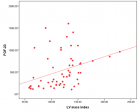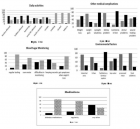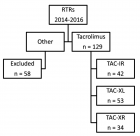Abstract
Research Article
An algorithm to safely manage oral food challenge in an office-based setting for children with multiple food allergies
Nathalie Cottel, Aïcha Dieme, Véronique Orcel, Yannick Chantran, Mélisande Bourgoin-Heck and Jocelyne Just
Published: 11 August, 2021 | Volume 5 - Issue 1 | Pages: 030-037
Background: In France, from 30% to 35% of children suffer from multiple food allergies (MFA). The gold standard to diagnosis a food allergy is the oral food challenge (OFC) which is conducted in a hospital setting due to risk of anaphylaxis.
The aim of this study was to evaluate an algorithm to predict OFCs at low risk of anaphylaxis that could safely be performed in an office-based setting.
Methods: Children with MFA and at least one open OFC reactive or non-reactive to other allergens were included. The algorithm was based on multiple clinical and biological parameters related to food allergens, and designed mainly to predict “low-risk” OFCs i.e., practicable in an office-based setting. The algorithm was secondarily tested in a validation cohort.
Results: Ninety-one children (median age 9 years) were included; 94% had at least one allergic comorbidity with an average of three OFCs per child. Of the 261 OFCs analyzed, most (192/261, 74%) were non-reactive. The algorithm failed to correctly predict 32 OFCs with a potentially detrimental consequence but among these only three children had severe symptoms. One hundred eighty-four of the 212 “low-risk” OFCs, (88%) were correctly predicted with a high positive predictive value (87%) and low negative predictive value (44%). These results were confirmed with a validation cohort giving a specificity of 98% and negative predictive value of 100%.
Conclusion: This study suggests that the algorithm we present here can predict “low-risk” OFCs in children with MFA which could be safely conducted in an office-based setting. Our results must be confirmed with an algorithm-based machine-learning approach.
Read Full Article HTML DOI: 10.29328/journal.aaai.1001027 Cite this Article Read Full Article PDF
Keywords:
Multiple food allergies; Children; Specific IgE; Allergen component; Algorithm
References
- Sicherer SH, Sampson HA. Food allergy: A review and update on epidemiology, pathogenesis, diagnosis, prevention, and management. J Allergy Clin Immunol. 2018; 141: 41‑ PubMed: https://pubmed.ncbi.nlm.nih.gov/29157945/
- Gupta RS, Springston EE, Warrier MR, Smith B, Kumar R, et al. The Prevalence, Severity, and Distribution of Childhood Food Allergy in the United States. Pediatrics. 2011; 128: 9‑ PubMed: https://pubmed.ncbi.nlm.nih.gov/21690110/
- Deschildre A, Lejeune S, Roussel J, Pouessel G, Mordacq C, et al. Polyallergie et risque d’accident allergique aigu grave. Rev Fr Allergol. 2018; 58: 167‑16
- Juchet A, Chabbert-Broué A. Les allergies alimentaires multiples de l’enfant. Rev Fr Allergol. 2013; 53: 523‑52
- Turner PJ, Gowland MH, Sharma V, Ierodiakonou D, Harper N, et al. Increase in anaphylaxis-related hospitalizations but no increase in fatalities: An analysis of United Kingdom national anaphylaxis data, 1992-2012. J Allergy Clin Immunol. 2015; 135: 956-963. PubMed: https://pubmed.ncbi.nlm.nih.gov/25468198/
- Pouessel G, Deschildre A. Anaphylaxie de l’enfant. Rev Fr Allergol. 2017; 57: 558‑
- Renaudin JM, Beaumont P, Sabouraud D, Dumond P, Liabeuf V, et al. Anaphylaxie alimentaire sévère : données recueillies par le Réseau d’Allergo-Vigilance ® (2002–2017) et allergènes émergents. Rev Fr Allergol. 2017; 57: 3‑
- Eapen AA, Lavery WJ, Siddiqui JS, Lierl MB. Oral immunotherapy for multiple foods in a pediatric allergy clinic setting. Ann Allergy Asthma Immunol. 2019; 123: 573-581. PubMed: https://pubmed.ncbi.nlm.nih.gov/31494236/
- Park JH, Ahn SS, Sicherer SH. Prevalence of Allergy to Multiple Versus Single Foods in a Pediatric Food Allergy Referral Practice. J Allergy Clin Immunol. 2010; 125: AB216.
- Foong RX, du Toit G, Fox AT. Asthma, Food Allergy, and How They Relate to Each Other. Front Pediatr.2017; 5: 89. PubMed: https://pubmed.ncbi.nlm.nih.gov/28536690/
- Michaud B, Amat F, Bourgoin-Heck M, Lambert N, Talon P, et al. Peut-on remplacer un test de provocation orale par un test biologique ? Rev Fr Allergol. 2017; 57: 114‑11
- Wang J. Management of the Patient with Multiple Food Allergies. Curr Allergy Asthma Rep. 2010; 10: 271‑27 PubMed: https://pubmed.ncbi.nlm.nih.gov/20431971/
- Cox AL, Nowak-Wegrzyn A. Innovation in Food Challenge Tests for Food Allergy. Curr Allergy Asthma Rep. 2018; 18: 74. PubMed: https://pubmed.ncbi.nlm.nih.gov/30377836/
- Matricardi PM, Kleine-Tebbe J, Hoffmann HJ, Valenta R, Hilger C, et al. EAACI Molecular Allergology User’s Guide. Pediatr Allergy Immunol. 2016; 27: 1‑PubMed: https://pubmed.ncbi.nlm.nih.gov/2728833/
- Sampson HA, Gerth van Wijk R, Bindslev-Jensen C, Sicherer S, Teuber SS, et al. Standardizing double-blind, placebo-controlled oral food challenges: American Academy of Allergy, Asthma & Immunology–European Academy of Allergy and Clinical Immunology PRACTALL consensus report. J Allergy Clin Immunol. 2012; 130: 1260‑12PubMed: https://pubmed.ncbi.nlm.nih.gov/23195525/
- Dyer AA, Gupta R. Epidemiology of Childhood Food Allergy. Pediatr Ann. 2013; 42: 101‑ PubMed: https://pubmed.ncbi.nlm.nih.gov/23718236/
- Simberloff T, Parambi R, Bartnikas LM, Broyles AD, Hamel V, et al. Implementation of a Standardized Clinical Assessment and Management Plan (SCAMP) for Food Challenges. J Allergy Clin Immunol Pract. 2017; 5: 335-344. PubMed: https://pubmed.ncbi.nlm.nih.gov/27373725/
- Global Initiative for Asthma. Global Strategy for Asthma Management and Prevention, 2019. ginasthma.org
- Braun JJ, Devillier P, Wallaert B, Rancé F, Jankowski R, et al. Recommandations pour le diagnostic et la prise en charge de la rhinite allergique (épidémiologie et physiopathologie exclues). Rev Mal Respir. 2010; 27: S79‑PubMed: https://pubmed.ncbi.nlm.nih.gov/20889026/
- Severity Scoring of Atopic Dermatitis: The SCORAD Index. Dermatology. 1993; 186: 23‑ PubMed: https://pubmed.ncbi.nlm.nih.gov/8435513/
- Deschildre A, Lejeune S. How to cope with food allergy symptoms? Curr Opin Allergy Clin Immunol. 2018; 18: 234‑2PubMed: https://pubmed.ncbi.nlm.nih.gov/29608467/
- Sindher S, Long AJ, Purington N, Chollet M, Slatkin S, et al. Analysis of a Large Standardized Food Challenge Data Set to Determine Predictors of Positive Outcome Across Multiple Allergens. Front Immunol. 2018; 9: 2689. PubMed: https://pubmed.ncbi.nlm.nih.gov/30538699/
- Eigenmann PA, Lack G, Mazon A, Nieto A, Haddad D, Brough HA, et al. Managing Nut Allergy: A Remaining Clinical Challenge. J Allergy Clin Immunol Pract. 2017; 5: 296‑PubMed: https://pubmed.ncbi.nlm.nih.gov/27793601/
- Ball H, Luyt D, Bravin K, Kirk K. Single nut or total nut avoidance in nut allergic children: outcome of nut challenges to guide exclusion diets: Oral nut challenges inform exclusion diets. Pediatr Allergy Immunol. 2011; 22: 808‑8 PubMed: https://pubmed.ncbi.nlm.nih.gov/21929602/
- Niggemann B, Beyer K. Factors augmenting allergic reactions. Allergy. 2014; 69: 1582‑158PubMed: https://pubmed.ncbi.nlm.nih.gov/25306896/
- Brough HA, Caubet J-C, Mazon A, Haddad D, Bergmann MM, et al. Defining challenge-proven coexistent nut and sesame seed allergy: A prospective multicenter European study. J Allergy Clin Immunol. 2020; 145: 1231‑123 PubMed: https://pubmed.ncbi.nlm.nih.gov/31866098/
- DunnGalvin A, Daly D, Cullinane C, Stenke E, Keeton D, et al. Highly accurate prediction of food challenge outcome using routinely available clinical data. J Allergy Clin Immunol. 2011; 127: 633-639. PubMed: https://pubmed.ncbi.nlm.nih.gov/21377032/
- Yanagida N, Sato S, Takahashi K, Nagakura K, Asaumi T, et al. Increasing specific immunoglobulin E levels correlate with the risk of anaphylaxis during an oral food challenge. Pediatr Allergy Immunol. 2018; 29: 417‑4 PubMed: https://pubmed.ncbi.nlm.nih.gov/9575164/
- Pettersson ME, Koppelman GH, Flokstra-de Blok BMJ, Kollen BJ, Dubois AEJ. Prediction of the severity of allergic reactions to foods. Allergy. 2018; 73: 1532‑15PubMed: https://pubmed.ncbi.nlm.nih.gov/29380392/
- Mehta N, Devarakonda MV. Machine learning, natural language programming, and electronic health records: The next step in the artificial intelligence journey? J Allergy Clin Immunol. 2018; 141: 2019-2021. PubMed: https://pubmed.ncbi.nlm.nih.gov/29518424/
- Messinger AI, Luo G, Deterding RR. The doctor will see you now: How machine learning and artificial intelligence can extend our understanding and treatment of asthma. J Allergy Clin Immunol. 2020; 145: 476‑47 PubMed: https://pubmed.ncbi.nlm.nih.gov/31883444/
- Bird JA, Groetch M, Allen KJ, Bock SA, Leonard S, et al. Conducting an Oral Food Challenge to Peanut in an Infant. J Allergy Clin Immunol Pract. 2017; 5: 301-311. PubMed: https://pubmed.ncbi.nlm.nih.gov/27838326/
Figures:

Figure 1

Figure 2
Similar Articles
-
Atopic Conjunctivitis in Children: Influence of Treatment with Topical Cyclosporin 0.05% in the Quality of LifeCarlos Alberto Sánchez Salguero*,Álvaro Isidro Sánchez Chacón. Atopic Conjunctivitis in Children: Influence of Treatment with Topical Cyclosporin 0.05% in the Quality of Life . . 2017 doi: 10.29328/journal.haard.1001001; 1: 001-008
-
Chemo-cytokines network is main target for control of Allergic asthmaSeyyed Shamsadin Athari*,Seyyede Masoume Athari. Chemo-cytokines network is main target for control of Allergic asthma. . 2018 doi: 10.29328/journal.aaai.1001009; 2: 001-002
-
Role of Serum Magnesium levels in Asthmatic with childrenSomashekar AR*,Ramakrishnan KG,Seyyed Vanitha Gowda. Role of Serum Magnesium levels in Asthmatic with children. . 2018 doi: 10.29328/journal.aaai.1001010; 2: 003-005
-
Diagnosis of Asthma in Childhood AgeIbrahim A Ali*,Elia Adil Nabih,Ahmed MS Eltohami. Diagnosis of Asthma in Childhood Age . . 2018 doi: 10.29328/journal.aaai.1001012; 2: 008-012
-
Helping asthmatic children through bonding therapyAntonio Madrid*,Nicholas Bennett. Helping asthmatic children through bonding therapy. . 2021 doi: 10.29328/journal.aaai.1001022; 5: 001-007
-
A retrospective cohort study to evaluate the relationship of airway hyperresponsiveness to type 2 biomarkers in persistent asthmaRory Chan,Chris RuiWen Kuo,Brian Lipworth*. A retrospective cohort study to evaluate the relationship of airway hyperresponsiveness to type 2 biomarkers in persistent asthma. . 2021 doi: 10.29328/journal.aaai.1001023; 5: 008-013
-
Higher venom-specific IgE levels differentiate children with previous local large reactions from children with previous systemic reactions of different severityPastorello Elide Anna*,Borgonovo Linda,Piantanida Marta,Schroeder Jan Walter,Pravettoni Valerio,Pastori Stefano,Bilo’ Maria Beatrice,Toniato Andrea,Aversano Maria Gloria,Farioli Laura,Nichelatti Michele,Preziosi Donatella. Higher venom-specific IgE levels differentiate children with previous local large reactions from children with previous systemic reactions of different severity. . 2021 doi: 10.29328/journal.aaai.1001025; 5: 017-021
-
An algorithm to safely manage oral food challenge in an office-based setting for children with multiple food allergiesNathalie Cottel,Aïcha Dieme,Véronique Orcel,Yannick Chantran,Mélisande Bourgoin-Heck,Jocelyne Just. An algorithm to safely manage oral food challenge in an office-based setting for children with multiple food allergies. . 2021 doi: 10.29328/journal.aaai.1001027; 5: 030-037
-
Efficacy and Safety of Sublingual Immunotherapy using a Combination of Dermatophagoides Pteronyssinus and Blomia Tropicalis Extracts in Patients with Allergic Rhinitis: A Randomized, Double-Blind, Placebo-Controlled TrialPriscilla Rios Cordeiro Macedo, Priscila Moraes, Luisa Karla Arruda, Fábio Fernandes Morato Castro, Jorge Kalil, Clóvis Eduardo Santos Galvão*. Efficacy and Safety of Sublingual Immunotherapy using a Combination of Dermatophagoides Pteronyssinus and Blomia Tropicalis Extracts in Patients with Allergic Rhinitis: A Randomized, Double-Blind, Placebo-Controlled Trial. . 2023 doi: 10.29328/journal.aaai.1001033; 7: 023-031
Recently Viewed
-
Outpatient operative hysteroscopy: evaluation of patient satisfaction and acceptanceClare Margaret Crowley*,Noelle Gill,Minna Geisler. Outpatient operative hysteroscopy: evaluation of patient satisfaction and acceptance. Clin J Obstet Gynecol. 2022: doi: 10.29328/journal.cjog.1001098; 5: 005-008
-
Predictors of positive treatment response to PTNS in women with overactive bladderSuneetha Rachaneni*,Doyo Enki,Megan Welstand,Thomasin Heggie,Anupreet Dua. Predictors of positive treatment response to PTNS in women with overactive bladder. Clin J Obstet Gynecol. 2022: doi: 10.29328/journal.cjog.1001097; 5: 001-004
-
Prediction of neonatal and maternal index based on development and population indicators: a global ecological studySedigheh Abdollahpour,Hamid Heidarian Miri,Talat Khadivzadeh*. Prediction of neonatal and maternal index based on development and population indicators: a global ecological study. Clin J Obstet Gynecol. 2021: doi: 10.29328/journal.cjog.1001096; 4: 101-105
-
A Genetic study in assisted reproduction and the risk of congenital anomaliesKaparelioti Chrysoula,Koniari Eleni*,Efthymiou Vasiliki,Loutradis Dimitrios,Chrousos George,Fryssira Eleni. A Genetic study in assisted reproduction and the risk of congenital anomalies. Clin J Obstet Gynecol. 2021: doi: 10.29328/journal.cjog.1001095; 4: 096-100
-
Leiomyosarcoma in pregnancy: Incidental finding during routine caesarean sectionToon Wen Tang*,Phoon Wai Leng Jessie. Leiomyosarcoma in pregnancy: Incidental finding during routine caesarean section. Clin J Obstet Gynecol. 2021: doi: 10.29328/journal.cjog.1001094; 4: 092-095
Most Viewed
-
Evaluation of Biostimulants Based on Recovered Protein Hydrolysates from Animal By-products as Plant Growth EnhancersH Pérez-Aguilar*, M Lacruz-Asaro, F Arán-Ais. Evaluation of Biostimulants Based on Recovered Protein Hydrolysates from Animal By-products as Plant Growth Enhancers. J Plant Sci Phytopathol. 2023 doi: 10.29328/journal.jpsp.1001104; 7: 042-047
-
Sinonasal Myxoma Extending into the Orbit in a 4-Year Old: A Case PresentationJulian A Purrinos*, Ramzi Younis. Sinonasal Myxoma Extending into the Orbit in a 4-Year Old: A Case Presentation. Arch Case Rep. 2024 doi: 10.29328/journal.acr.1001099; 8: 075-077
-
Feasibility study of magnetic sensing for detecting single-neuron action potentialsDenis Tonini,Kai Wu,Renata Saha,Jian-Ping Wang*. Feasibility study of magnetic sensing for detecting single-neuron action potentials. Ann Biomed Sci Eng. 2022 doi: 10.29328/journal.abse.1001018; 6: 019-029
-
Pediatric Dysgerminoma: Unveiling a Rare Ovarian TumorFaten Limaiem*, Khalil Saffar, Ahmed Halouani. Pediatric Dysgerminoma: Unveiling a Rare Ovarian Tumor. Arch Case Rep. 2024 doi: 10.29328/journal.acr.1001087; 8: 010-013
-
Physical activity can change the physiological and psychological circumstances during COVID-19 pandemic: A narrative reviewKhashayar Maroufi*. Physical activity can change the physiological and psychological circumstances during COVID-19 pandemic: A narrative review. J Sports Med Ther. 2021 doi: 10.29328/journal.jsmt.1001051; 6: 001-007

HSPI: We're glad you're here. Please click "create a new Query" if you are a new visitor to our website and need further information from us.
If you are already a member of our network and need to keep track of any developments regarding a question you have already submitted, click "take me to my Query."


















































































































































